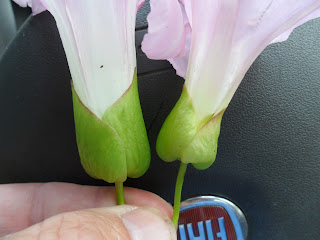2017 has been another wonderful year for Wexford botany.
Records collected
in 2017
104,283 records collected. 2016 being the only year with a
higher number of records.
Recorders
41 people contributed records, plus the Wexford Naturalists’
Field Club gave records from their field meetings.
New species
25 new species, hybrids and varieties were added to the
county list in 2017. Of these 8 are native.
Anaphalis
margaritacea (Pearly Everlasting)
Anthriscus
cerefolium (Garden Chervil)
Atriplex glabriuscula (Babington's Orache) x A. praecox (Early Orache)
Atriplex praecox (Early Orache)
Brassica
oleracea var. capitata
Brassica oleracea
var. oleracea
Carex canescens (White Sedge)
Chaenomeles
speciosa (Japanese Quince)
Crocus x luteus (Yellow Crocus (C. angustifolius x C. flavus))
Erica erigena
(Irish Heath)
Euphorbia stricta
(Upright Spurge)
Galeopsis ladanum
(Broad-leaved Hemp-nettle)
Geranium reuteri
(Canary Herb-robert)
Juncus x diffusus (J. effusus (Soft Rush) x J. inflexus
(Hard Rush))
Mycelis muralis
(Wall Lettuce)
Ophrys apifera var. trollii (Wasp Orchid)
Paeonia lutea (Yellow
Tree Peony)
Parentucellia viscosa (Yellow Bartsia)
Raphanus sativus
var. oleifera (Fodder Radish)
Rubus parviflorus
(Thimbleberry)
Scilla siberica
(Siberian Squill)
Sedum sexangulare
(Tasteless Stonecrop)
Sorbaria sorbifolia
(Sorbaria)
Taraxacum ronae
Ulex x breoganii (U. europaeus
(Gorse) x U. gallii (Western Gorse))
Extinct species
Of the 160 species not recorded in Wexford post 2000, 7 of
these were found in 2017. 4 are native. The date given is the
last year the species was reported from the county.
Amaranthus hybridus
(Green Amaranth) 1990.
Baldellia ranunculoides (Lesser Water-plantain)
1993.
Betula x aurata (B. pendula
(Silver Birch) x B. pubescens (Downy
Birch)) 1992.
Euphorbia
amygdaloides (Wood Spurge) 1955.
Festuca altissima (Wood Fescue) 1964.
Malva neglecta
(Dwarf Mallow) 1976.
Pinguicula vulgaris (Common Butterwort) 1992.
Hectad data
Of the 42 whole and part hectads (10 km x 10 km square) that
fall within Wexford all now have 200 plus species recorded. All whole hectads
have 700 plus species. 12 hectads now have 800 plus species, of these 2 have
over 900 species and T02 (which includes Wexford Town) has 1023 species.
Tetrad data
Of the 687 whole and part tetrads (2 km x 2 km square) that
fall within Wexford all have been visited. 28 of these have over 400 species
recorded, and 4 have over 500 species. T12E Ballinesker (NE of Curracloe) is
the highest scoring tetrad with 524 species.
Monad data
Of the 2461 whole or part monads (1 km x 1 km square), 421
have no records or less than 100 species recorded. 360 monads have 200 plus
species recorded, of these 20 have 300 plus species. The highest being S7115
Dunbrody with 389 species.
The above map shows all the monads with one or more species
recorded. The white squares amongst the green are the monads with no records. Map produced from the BSBI DDb.


















































